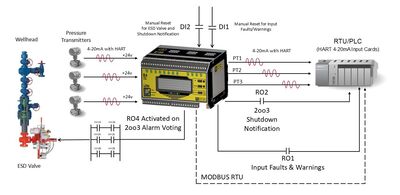High Integrity Pressure Protection System (HIPPS) 2oo3 voting shutdown system

Oil and gas operations rely on precise pressure monitoring and management to maintain safe and efficient upstream processes. Because pressures in gas wellheads can reach 10,000 psi, pressure protection is essential to maintaining operational integrity. Failure to appropriately control pressure can result in catastrophic equipment damage, environmental damage, and potentially fatal outcomes.
To mitigate such hazards, a High Integrity Pressure Protection System (HIPPS) is used, with the Moore Industries SLA Multiloop and Multifunctional Logic Solver in a 2oo3 (two-out-of-three) voting architecture. This configuration ensures excellent reliability and availability of wellhead shutdown in response to overpressure conditions.
System overview
The HIPPS shutdown system incorporates the following key components:
- Three Smart HART pressure transmitters (0–10,000 psi range)
- Moore Industries SLA Multiloop and Multifunctional Logic Solver
- Remote terminal unit (RTU) or programmable logic controller (PLC)
- Emergency shutdown (ESD) valve.
In this architecture, three pressure transmitters continuously monitor wellhead pressure. These transmitters are directly connected to the SLA, which evaluates the signals and performs a 2oo3 voting decision. If at least two of the three pressure transmitters detect a pressure of 8,700 psi or higher, the SLA initiates a wellhead shutdown by triggering the ESD valve. The SLA’s built-in loop power supply on each of its three channels provides operating power to all three smart HART pressure transmitters. The HART signal from the three pressure transmitters is passed through to each of the SLA’s corresponding analog outputs so the RTU or PLC has direct access to all HART programming, variables, and diagnostics of each connected transmitter.
The retransmission of these three pressure transmitters by the SLA, versus wiring in series with the RTU or PLC input cards, provides higher availability to the safety function since a catastrophic failure in the analog input cards or the RTU/PLC itself doesn’t affect the 2oo3 logic shutdown function of the SLA.
Additional relay outputs of the SLA also keep the RTU or PLC informed of shutdown status and any input faults experienced by the SLA. A digital contact input allows any alarm or relay configured as latching to be manually reset. Finally, all inputs, outputs, internal equations, variables, alarms, relay status and more are digitally transmitted to the RTU or PLC via a read-only Modbus RTU signal.

Key features and benefits of the SLA in HIPPS
1. Integrated loop power supply
The SLA includes a built-in loop power supply for each of its three input channels, providing direct operating power to all three smart HART pressure transmitters. This eliminates the need for external power sources and enhances system reliability.
2. HART signal pass-through for enhanced diagnostics
Each of the SLA’s analog outputs retransmits the HART signal from the pressure transmitters, allowing the RTU or PLC to access:
- HART programming
- process variables
- device diagnostics.
Predictive maintenance and quick defect identification are made possible by this HART pass-through functionality, which guarantees that the RTU/PLC maintains complete access to transmitter health and operating data.
3. Increased safety and availability
Rather than wiring the pressure transmitters in series with RTU or PLC input cards, the SLA independently processes the signals and retransmits them. This design enhances safety and availability in several ways:
- A failure in the RTU or PLC analog input cards does not impact the HIPPS shutdown logic.
- The SLA maintains functional integrity independently of the RTU or PLC.
- Even if the RTU or PLC fails or needs to be taken offline, the SLA remains operational and capable of executing the 2oo3 shutdown function.
4. Relay outputs for shutdown execution and comprehensive monitoring
The SLA provides dedicated relay outputs that:
- indicate shutdown status to the RTU or PLC
- notify of any detected input faults or warnings
- initiates the ESD valve shutdown function.
This ensures critical status updates are always available remotely and shutdown execution takes place instantaneously.
5. Discrete inputs for manual reset and control
The system utilises two discrete inputs to:
- reset for latched input faults or warnings
- reset shutdown notification to the PLC/RTU
- provide manual reset of the ESD valve shutdown relay.
This feature allows operators to acknowledge and manage system events efficiently.
6. Modbus RTU communication for digital monitoring
All system inputs, outputs, alarms, and relay statuses are transmitted to the RTU or PLC via a read-only Modbus RTU signal. This ensures:
- seamless integration with existing control systems
- remote monitoring capabilities
- digital logging of system events for compliance and auditing.
Conclusion
The Moore Industries SLA Multiloop and Multifunctional Logic Solver plays a pivotal role in implementing a robust HIPPS for upstream gas wellhead applications. By leveraging a 2oo3 voting architecture, integrated loop power supplies, and HART signal pass-through, the system ensures high integrity, fault tolerance, and operational reliability. Furthermore, the SLA’s independent logic processing enhances safety by maintaining shutdown capabilities even in the event of RTU or PLC failures.
As oil and gas operations demand stricter safety requirements, SLA-based HIPPS offers a tried-and-true solution for reducing overpressure hazards while increasing system uptime and process efficiency.
For more information go to www.miinet.com/SLA.
Pilz delivers compliant access management system at Schüco's testing facility
Schüco envisioned a centralised permissions management system that would streamline access...
Navigating SIF logic solver selection: Why the Moore Industries SLA stands out
It is important to select a logic solver that is not just well-documented but fully compliant...
Selecting instrumentation for functional safety (SIL) applications
Over the past couple of decades, the process industries have seen many changes when it comes to...











